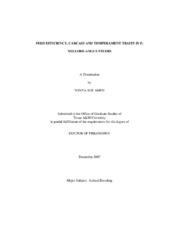| dc.description.abstract | Feed efficiency in fed F2 Nellore-Angus steers produced through embryo transfer was evaluated using two methods: residual feed intake (RFI) and NRC-based model predicted residual consumption (MPRC). Sire and family(sire) both contributed to differences in model predicted residual consumption (P = 0.036 and P < 0.001, respectively), but not in RFI (P = 0.117 and 0.455, respectively). This indicates that variation exists among the sires and families studied, and the opportunity exists to improve MPRC through selection; it also indicates these 2 evaluation methods could result in different conclusions about feed efficiency. Five aspects of temperament were also evaluated (aggressiveness, nervousness, flightiness, gregariousness, and overall temperament) on a 9-point scale shortly after weaning. Sire had a significant effect on all 5 aspects of temperament evaluated, but family was only responsible for variation in aggressiveness, nervousness, and overall temperament. Contemporary group had no effect on aggressiveness, but did contribute significantly to variation in all other temperament traits. All temperament traits were highly correlated with one another (r = 0.81 to 0.98). Recipient dam temperament was lowly correlated with gregariousness and overall temperament (r = 0.16 and 0.15, respectively), and the correlations with recipient dam temperament approached significance for aggressiveness, nervousness and flightiness. This suggests that the temperament of the recipient female may have a small effect on the temperament of the calf. This population was structured to identify QTL for economically important traits and appears to be useful to identify genetic markers for feed efficiency and animal temperament. | en |


